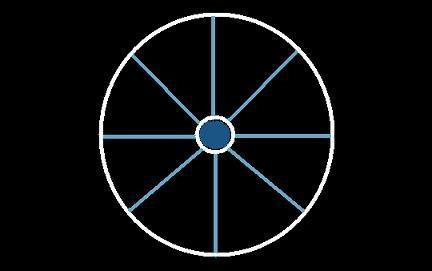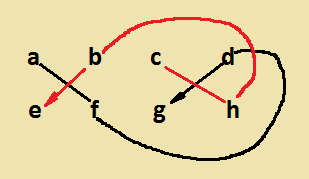NEW MAGIC SQUARES WHEEL METHOD
Part VIII
7x7 Wheel Border Magic Square
A magic square is an arrangement of numbers 1,2,3,... n2 where every row,
column and diagonal add up to the same magic sum S and n is also the order
of the square. A magic square having all pairs of cells diametrically equidistant
from the center of the square and equal to the sum of the first and last terms of the series
n2 + 1 is also called associated or symmetric. In addition,
the center of this type of square must always
contain the middle number of the series, i.e., ½(n2 + 1).
A second modified facile method for the construction of wheel type magic squares is now available. The position of the spokes are rotated by 90° so that
the left diagonal starts at the bottom left cell. The 5x5 square is first filled followed by the 7x7.
The 7x7 and the 5x5 squares are magic but not the 3x3 and this square is classified as a partial border.
The new magic squares with n = 7 are constructed as follows using a complimentary table as a guide.
| 1 | 2 |
3 | 4 | 5 | 6 |
7 | 8 | 9 | 10 |
11 | 12 | 13 | 14 |
15 | 16 | 17 | 18 |
19 | 20 | 21 | 22 |
23 | 24 |
| 25 |
| 49 | 48 | 47 |
46 | 45 | 44 | 43 |
42 | 41 | 40 | 39 |
38 | 37 | 36 | 35 |
34 | 33 | 32 | 31 |
30 | 29 | 28 | 27 |
26 |
A 7x7 Magic Square Using the Pairs {22,23,24,25,26,27,28} and {2,13,20,25,30,37,48}
- The 7x7 square is to be filled with 25 numbers from a non sequential subset of numbers and their complements.
The spokes of the wheel are generated as follows: Numbers 22-28 in the left diagonal; numbers 2,13,20 and conjugates 48,37,30
in the right diagonal; numbers 1,12,21 and conjugates 49,38,29 in top to bottom center; and 3,14,19 and conjugates 47,36,31 in center horizontal (square A1). The addition
of these pair of numbers and conjugates to the 7x7 square are shown below using directional pointed arrows:
| 1 | 12 | 21 |
2 | 13 | 20 |
3 | 14 | 19 |
... |
22 | 23 | 24 |
| 25 |
| 49 | 38 | 29 |
48 | 37 | 30 |
47 | 44 | 41 |
... |
26 | 36 | 31 |
|
|
| ↓ | ↖ |
→ | ... | ↗ |
- Sum up the rows and columns 1-3 and 5-7 and subtract from the magic sum 175. This gives the amounts required (shown in green Square A2) The last column shows the
two amounts need to complete the row and column (shown in green).
- Fill in the internal square 5x5 with the numbers 15-18 and complements 35-32 according to the picture below using two adjacent pair of numbers.
-
Then fill in the external non-spoke cells (rows 1 and 7 and columns 1 and 7) with the numbers 4 to 11 and complements 46 to 39 as in the picture below.
A1
| 48 | | |
1 | | |
28 |
| | 37 | |
12 | | 27 |
|
| | | 30 | 21 |
26 | | |
| 3 | 14 | 19 |
25 | 31 |
36 | 47 |
| | | 24 |
29 | 20 |
| |
| | 23 | |
38 | |
13 | |
| 22 | | |
49 | | |
2 |
|
⇒ |
A2
| 48 | | |
1 | | |
28 | 98 | 49x2 |
| | 37 | |
12 | | 27 |
| 99 | 49+50 |
| | | 30 | 21 |
26 | | |
98 | 48+50 |
| 3 | 14 | 19 |
25 | 31 |
36 | 47 |
| |
| | | 24 |
29 | 20 |
| | 102 | 50+52 |
| | 23 | |
38 | |
13 | | 101 | 50+51 |
| 22 | | |
49 | | |
2 | 102 | 51x2 |
| 102 | 101 | 102 |
| 98 | 99 |
98 | | |
|
⇒ |
A3
| 48 | | |
1 | | |
28 |
| 37 | 17 |
12 | 32 | 27 |
|
| 33 | 30 |
21 | 26 |
15 | |
| 3 | 14 | 19 |
25 | 31 |
36 | 47 |
| 18 | 24 |
29 | 20 |
34 | |
| 23 | 35 |
38 | 16 |
13 | |
| 22 | | |
49 | | |
2 |
|
⇒ |
A4
| 48 | 4 | 6 |
1 | 43 | 45 |
28 |
| 42 | 37 | 17 |
12 | 32 | 27 |
8 |
| 40 | 33 | 30 |
21 | 26 |
15 | 10 |
| 3 | 14 | 19 |
25 | 31 |
36 | 47 |
| 11 | 18 | 24 |
29 | 20 |
34 | 39 |
| 9 | 23 | 35 |
38 | 16 |
13 | 41 |
| 22 | 46 | 44 |
49 | 7 | 5 |
2 |
|
⇒ |
A4 Border
| 48 | 4 | 6 |
1 | 43 | 45 |
28 |
| 42 | 37 | 17 |
12 | 32 | 27 |
8 |
| 40 | 33 | 30 |
21 | 26 |
15 | 10 |
| 3 | 14 | 19 |
25 | 31 |
36 | 47 |
| 11 | 18 | 24 |
29 | 20 |
34 | 39 |
| 9 | 23 | 35 |
38 | 16 |
13 | 41 |
| 22 | 46 | 44 |
49 | 7 | 5 |
2 |
|
| 1 | 2 |
3 | 4 |
5 | 6 |
7 | 8 |
9 | 10 |
11 | 12 | 13 |
14 | 15 | 16 |
17 | 18 |
19 | 20 | 21 |
22 |
23 | 24 |
| 25 |
| 49 | 48 |
47 | 46 | 45 |
44 | 43 | 42 |
41 | 40 | 39 |
38 | 37 | 36 |
35 | 34 |
33 | 32 |
31 | 30 |
29 | 28 |
27 | 26 |
This completes part VI of a border Magic Square Wheel method. To see the next 9x9 Part IX.
Go back to homepage.
Copyright © 2015 by Eddie N Gutierrez.



